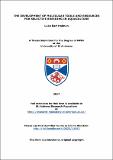Files in this item
The development of molecular tools and resources for selective breeding in aquaculture
Item metadata
| dc.contributor.advisor | Johnston, Ian A | |
| dc.contributor.author | Holman, Luke Earl | |
| dc.coverage.spatial | 91 | en_US |
| dc.date.accessioned | 2017-10-13T12:13:37Z | |
| dc.date.available | 2017-10-13T12:13:37Z | |
| dc.date.issued | 2017-06-21 | |
| dc.identifier.uri | https://hdl.handle.net/10023/11843 | |
| dc.description.abstract | Human population growth is predicted to continue well into the 21st century, and beyond. The provision of selectively bred organisms will be an essential part of global food security. While the selective breeding of terrestrial animals has been essential to the human success story, the breeding of aquatic organisms has only recently received serious attention. Aquaculture research urgently needs both specific genetic resources for existing aquatic species, and generalised workflows and pipelines for the generation of resources for newly cultivated species. This study presents a stochastic simulation of a selective program for the gilthead seabream (Sparus aurata L.). The simulation models the change of a non-selective breeding program to a scheme improving growth rate by mass selection. The effect of selection on growth rate, inbreeding and projected profits are modelled explicitly. The simulation predicts a profitable and sound breeding scheme for gilthead seabream and can also be easily adapted for new traits and species. A workflow for the filtration of an optimal number genetic variants for molecular parentage assignment was also developed and validated in Atlantic salmon (Salmo salar L.). A discovery dataset of 102 Atlantic salmon from three distinct aquaculture strains were subject to restriction site associated DNA marker sequencing. The resultant single nucleotide polymorphisms were filtered according to quality, property and suitability for probe-based high-throughput genotyping technology. The final SNP panel consisted of 94 mass genotyping assays that gave 100% accurate parentage in independent samples of known pedigree. Finally, a set of standardised trait descriptors were designed for bivalve molluscs to accompany next generation sequencing submissions. These standards are needed to provide consistent trait measurements between investigators for quality control and to enable interoperability of phenotypic and genotypic data in future meta analyses. | en_US |
| dc.language.iso | en | en_US |
| dc.publisher | University of St Andrews | en |
| dc.rights | Attribution 4.0 International | * |
| dc.rights.uri | http://creativecommons.org/licenses/by/4.0/ | * |
| dc.subject | Aquaculture | en_US |
| dc.subject | Selective breeding | en_US |
| dc.subject | Simulations | en_US |
| dc.subject | Gilthead seabream | en_US |
| dc.subject | Parentage assignment | en_US |
| dc.subject | Traceability | en_US |
| dc.subject | Standards | en_US |
| dc.subject | Atlantic salmon | en_US |
| dc.subject.lcc | SH155.5H76 | |
| dc.subject.lcsh | Aquaculture. | en |
| dc.subject.lcsh | Fishes--Breeding. | en |
| dc.subject.lcsh | Fishes--Molecular genetics. | en |
| dc.title | The development of molecular tools and resources for selective breeding in aquaculture | en_US |
| dc.type | Thesis | en_US |
| dc.type.qualificationlevel | Doctoral | en_US |
| dc.type.qualificationname | MPhil Master of Philosophy | en_US |
| dc.publisher.institution | The University of St Andrews | en_US |
The following licence files are associated with this item:
This item appears in the following Collection(s)
Except where otherwise noted within the work, this item's licence for re-use is described as Attribution 4.0 International
Items in the St Andrews Research Repository are protected by copyright, with all rights reserved, unless otherwise indicated.


